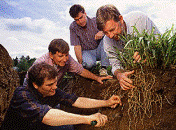United States Department of Agriculture: Agricultural Research Service, Lincoln, Nebraska

United States Department of Agriculture-Agricultural Research Service / University of Nebraska-Lincoln: Faculty Publications
Document Type
Book Chapter
Date of this Version
2022
Citation
Green, B. W. (2022). Fertilizer use in aquaculture. Pages 29-63 in D.A. Davis (Editor), Feeds and Feeding Practices in Aquaculture, Second Edition, Woodhead Publishing/Elsevier, Cambridge, Massachusetts, USA
book doi: 10.1016/B978-0-12-821598-2.00012-6
Abstract
Aquaculture ponds traditionally are fertilized to stimulate primary productivity, which serves as the base of the pond natural food web and provides ancillary ecosystem services. Fertilizer can be made regularly or based on some water quality variable or measure of algal productivity. Nutrients from chemical fertilizers are available sooner for phytoplankton growth compared to organic fertilizers that first must undergo microbial decomposition before nitrogen and phosphorus concentrations increase. Primary production increases with increased fertilizer application if productivity is limited by primary nutrients rather than by light. In semi-intensive and intensive production systems, natural pond productivity enhanced by targeted fertilization protocols can sustain rapid early growth of stocked juveniles until the critical standing crop is reached, at which time transition to compound or complete formulated feed is required for continued rapid growth. Fertilization contributes to establishing and maintaining a pond environment that allows the culture organism to utilize efficiently the compound or complete feeds offered. Aquaculture pond natural productivity, fertilizer nutrients and forms, and fertilization programs for young-of-year culture and fertilizer-feed strategies are discussed in this chapter.
Included in
Natural Resources and Conservation Commons, Terrestrial and Aquatic Ecology Commons, Water Resource Management Commons


Comments
United States government work